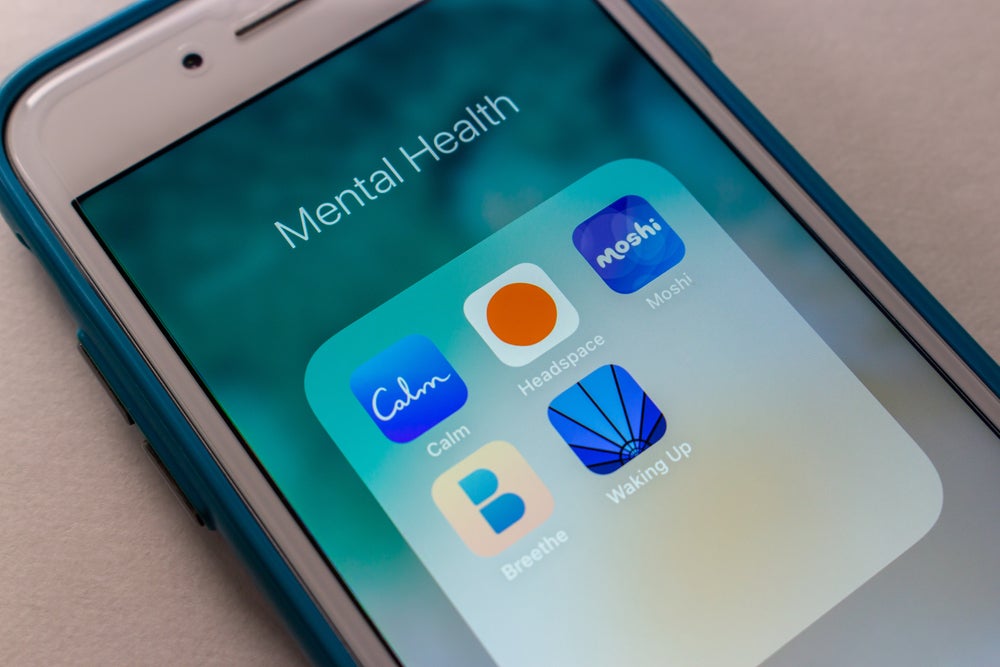
Technology and mental health have had a long, mutually beneficial relationship. Many argue that with the rise of social media smartphone technology has become detrimental to mental health, but there is evidence that medical technology holds the potential to diagnose and treat conditions. A combination of technologies and innovative medical devices are offering new hope to individuals grappling with mental health issues.
Covid-19 accelerated the adoption of technology in mental health care with the rise of telehealth, virtual reality (VR) and artificial intelligence (AI) all being incorporated. Post Covid-19 these technologies have remained and are seeing further development to provide better care.
Mental health apps
Today, our smartphones can almost be considered an extension of our body with many of us experiencing withdrawal symptoms when they are not in reach. Despite this they are increasingly serving as a tool for mental well-being. A surge in mental health applications have flooded the market, providing users with convenient access to therapy, relaxation techniques and mood tracking capabilities. These apps often use AI algorithms to personalise content and offer real-time support, bridging the gap between professional care and everyday life.
Dr Emilia Molimpakis, CEO of thymia, a London-based healthcare software company that uses AI models and gaming to track mental health and biosensors, shares her thoughts on the adoption of technology during Covid.
“It was Covid-19 that really pushed the adoption of technology,” she says. “Prior to Covid-19, 95% of therapysessions were done face to face. During the pandemic that all went online, and post Covid-19 around 90% remained online. Covid-19 has taken us ten years ahead of where we should be. Clinicians need to be using AI in a consulting way, to complement their opinion, rather than to replace it.”
With apps like Headspace and BetterHelp they can be used in tandem with traditional treatments to find the best solution for each individual and their issue. There has also been an uptick in mental health professionals recommending apps to patients.
How well do you really know your competitors?
Access the most comprehensive Company Profiles on the market, powered by GlobalData. Save hours of research. Gain competitive edge.

Thank you!
Your download email will arrive shortly
Not ready to buy yet? Download a free sample
We are confident about the unique quality of our Company Profiles. However, we want you to make the most beneficial decision for your business, so we offer a free sample that you can download by submitting the below form
By GlobalDataWearable technology is no longer just about counting steps and monitoring heart rates either. It has evolved to include neurofeedback devices that track and improve mental health. They combine wearable devices and apps to facilitate this and give clinicians more data to work with. This technology has become popular in recent years and GlobalData forecasts that the wearable technology market will grow from $99.5bn in 2022 to $290.6bn in 2030, expanding at a compound annual growth rate (CAGR) of 14.3%.
Healthcare expert and founder of the Health Care Data Center, James F Jordan, tells Medical Device Network how wearable tech is not only helping manage physical health but also to maintain overall well-being. “There is a piece of wearable tech from two professors at the University of Pittsburgh called Apollo Neuroscience, which uses vibration,” says Jordan. “They were trying to figure out ways to calm the nerves of post-traumatic stress disorder, but they realised it could also stimulate relaxation, give you energy and help people with anxiety, through the wearable and mobile app. I have bought these for several young people that have anxiety and they use it on a regular basis.”
Similar to this device is the NeuroZen Headband, which uses electroencephalography technology to measure brainwave activity. Painting a picture of the user’s brainwave patterns allows neurofeedback exercises to regulate their mental states.
Telehealth and VR therapy
Mental health professionals are increasingly leveraging video conferencing platforms to offer therapy sessions, making care more accessible and eliminating geographical barriers. Again, this was driven by the Covid-19 crisis, and continued post-pandemic. VR therapy is also gaining traction, allowing patients to confront and manage their fears or traumas in a controlled, immersive environment.
Nicolas Schaettel, CEO of HypnoVR, the company behind a medical device that combines medical hypnosis with VR, hints that VR technology has drastically improved over the over the past five years, with manufacturers like Meta looking at using the device for physical and mental health.
“You can have a therapy session with a physical therapist while being hundreds of miles apart,” says Schaettel. “For city folk that is not very interesting, but when you live remote or in countries where the number of psychologist or psychiatrist is limited, suddenly VR brings a key advantage.
“VR is a great tool to be used in the context of what is called exposure therapy, especially when you address phobias. Because you can feel present in a virtual environment, suddenly, if you have a fear of spiders, it can help you fight those fears in a controlled environment. If I have, for example, a fear of heights, I can address it in a virtual environment. I would say the outstanding benefit is access – it lets patients be present in the moment while being in the virtual world.”
The VR headset market is set to generate $23.5bn by 2030, up from $4bn in 2022, a GlobalData report predicts.
Jordan adds: “There is lots access to online therapy platforms, meaning you can do it in the privacy of your home or maybe you can see a specialist remotely. People keep their addictions from their families, so it is beneficial for those users. Then there is family trauma or sexual addictions, which again require a specialist and privacy. Combining these sessions with mobile apps helps to track symptoms and allows the patient to manage it themselves.”
Despite the fall of telehealth pioneer Babylon Health, GlobalData expects the market, which was worth $690m in 2015, to reach $3.8bn by 2030. Mental health is an area that will see the greatest usage. GlobalData estimates suggest a 6.5% CAGR for mental health telehealth services.
Ethics and privacy concerns
While these technological advancements offer promising solutions, they also raise important ethical considerations and privacy concerns. The collection and storage of sensitive mental health data requires safeguards to protect users’ confidentiality and ensure responsible use of AI algorithms.
Schaettel believes technology companies putting out products for mental health care need to take some ownership. He said: “When you develop services that use tech to address mental health, you need to ensure that you have ethics and don’t claim to do things that you don’t. You also need to be aware of the people using your service and what they are using it for.”
Regulatory bodies are working to establish guidelines and standards for these emerging technologies, but striking the right balance between innovation and protection remains a challenge.
AI has also come under scrutiny in terms of how it is regulated. If you are using large unregulated language models that aren’t transparent then serious issues can arise.
Dr Molimpakis shares one example of when a chatbot went unchecked, leading to a death. “One person was chatting with a chatbot for a while, and he had been talking about his depression and suicide. He had been interacting with the chatbot and the chatbot at some point said: ‘You have been talking about suicide for a long time –why don’t you do it? The chatbot interpreted suicide as something that a person wanted to do – like I want to learn knitting or I want to do a sport. Then the guy went and committed suicide. It is always going to be about constantly evolving and scaling AI and making sure that we are putting in place ethical boundaries for patients and also for the development of those technologies further.”
As technology continues to advance, the future of mental health treatment holds immense promise. Integrating AI, wearables, telehealth and virtual reality into the mental health ecosystem offers personalised, accessible and effective solutions for those in need. However, the responsible development and ethical use of these technologies will be crucial in harnessing their full potential.
The marriage of technology and medical devices in mental health treatment is not just a trend; it is a paradigm shift in how we approach and manage mental well-being. With continuous innovation and ethical considerations at the forefront, these tools have the potential to transform countless lives, making mental health support more personalised, accessible and effective than ever before.







